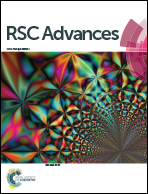Hollow polyphosphazene microspheres with cross-linked chemical structure: synthesis, formation mechanism and applications
Abstract
Hollow poly(cyclotriphosphazene-co-4,4′-sulfonyldiphenol) (PZS) microspheres with cross-linked chemical structure have been prepared under mild conditions by using polystyrene (PS) microspheres as sacrificial templates, hexachlorocyclotriphosphazene (HCCP) and 4,4′-sulfonyldiphenol (BPS) as comonomers, and triethylamine (TEA) as acid-acceptor. A template-induced assembly mechanism has been proposed to explain the formation of the hollow PZS microspheres. The as-prepared PS@PZS composites and hollow PZS microspheres were characterized by scanning electron microscopy (SEM), transmission electron microscopy (TEM), Fourier transform infrared (FT-IR) spectrometry, thermogravimetric analysis (TGA), and elemental analysis. The shell thickness of the hollow PZS microspheres can be controlled by adjusting the feed ratio of sacrificial templates to comonomers. An application study for the hollow PZS microspheres as a support of Au nanoparticles was carried out. The results show that Au nanoparticles with a size of about 5–8 nm were uniformly attached to the surface of the hollow PZS microspheres and the hollow PZS/Au hybrids displayed good catalytic properties with the reduction of 4-nitrophenol to 4-aminophenol as the model catalysis reaction.


 Please wait while we load your content...
Please wait while we load your content...